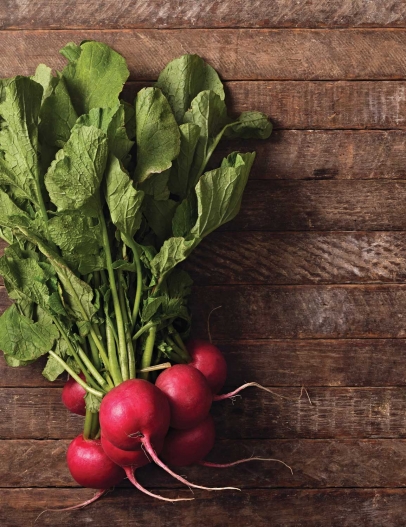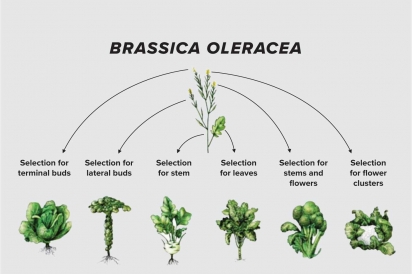The Beauty of Brassicas
Much more than mustard
WHILE BRASSICAS MIGHT not be a familiar term in every household, these nutrient-dense vegetables are no strangers to many foodies’ favorite recipes. More commonly known as cruciferous, these plants include grocery-list mainstays such as cabbage, cauliflower, broccoli, kale and radish.
This impressive genus of vegetables proves to be as versatile as it is colorful and is used the culinary world over for everything from vibrant garnishes to hearty entrees. In fact, the vast number of vegetables in this category (an astounding 3,700 species worldwide, according to Brittanica), can be delineated into practical subareas, namely:
• Leafy (think arugula, collard and mustard greens, watercress)
• Asian (such as bok choy, Chinese broccoli, napa cabbage)
• Root (including radish, turnip, rutabaga, horseradish wasabi)
• Plus standards collectively known as Brassica oleracea (such as kale, cauliflower, Brussels sprouts, cabbage, broccoli, kohlrabi).
Remarkably, the latter group is derived from a single hardworking plant type: wild mustard. While most would not consider wild mustard such a produce hero, all evidence is to the contrary. Cauliflower was bred from wild mustard’s flowers; broccoli from its flower and stems; kale from its leaves; kohlrabi is from stems; Brussels sprouts from the side buds; and cabbage from end buds.
Brassicaceae (reasonably, it’s commonly known as the mustard family) “includes more cultivated plants than any other [botanical] family the world over,” according to Ben Phillips, a vegetable specialist with Michigan State University. It is hardly surprising this awe-inspiring reach extends into Michigan.
“Michigan’s temperate climate actually provides an ideal environment for these crops. Most [crops’ maturity time frames] are short enough that they can even be grown twice in the same season.” The breadth of Brassicas grown in Michigan’s temperate zone makes sourcing fresh and locally grown vegetables quite easy—evidenced by the bounty of Brassicas often available in community-supported agriculture shares, farmers markets and the like. This is particularly wonderful news for Michiganders, as this plant family is full of true nutrition powerhouses.
According to Alison Ozgur, director of wellness programs at the T. Colin Campbell Center for Nutrition Studies, “in addition to adding a healthy dose of fiber to your diet, these vegetables are rich in phytonutrients, including beta-carotene, lutein, glucosinolates and zeaxanthin, plus vitamins C, K and E.” This means that every bite of cauliflower or kale is ultimately helping to “prevent oxidative stress, induce detoxification, stimulate the immune system and decrease the risk of cancers.” Translation? This family of plants is a veritable diet dynamo, helping to achieve cellular balance and health while promoting overall immunity against certain diseases.
The beauty of Brassicas also extends to their versatility of preparation. While most Brassicas can be enjoyed raw, preparation can range from braising and roasting to sautéing and steaming. If preparing, it is important not to overcook. Not only can this affect the flavor, but it can also reduce the nutritional load.
Generally, steaming appears to be one of the best ways to retain these glorious nutrients when preparing. According to Ozgur, boiling has been shown to decrease the number of glucosinolates (GLSs) formed in cooking; whereas steaming retains the highest amounts of GLSs. (Glucosinolates are sulfurrich and highly beneficial metabolites found mostly in the Brassicaceae family; specially known for their antioxidant and antimicrobial properties.) What’s more, Ozgur recommends preparing these plants with foods rich in vitamin C, such as lemon or lime juice, as this may increase the concentration of nutrients.
The mighty Brassica family delivers on so very many aspects. While presenting all the hallmarks of health, with its nutrient-dense offerings, this family also proves itself versatile in culinary use and preparation. Couple this with overall compatibility with Michigan’s climate and these vegetables are as accessible as they are appetizing. The beauty of Brassicas truly abounds.
Mary Bishop is a plant-based-food consultant and lifestyle writer based in Metro Detroit. Find her at TheVeganMary.co, @the.veganmary and @theveganmary.
THE BEST OF BRASSICAS
Arugula: Bold flavor lends itself to salads, as well as pesto and pasta
Bok choy: Delicate and light, perfect for steaming or sauteing
Broccoli: Both flower and stalk are edible and can be enjoyed raw or cooked
Brussels sprouts: These “minicabbages” have exploded in popularity, often served roasted or steamed
Cabbage: Commonly grown in white, red and green, as well as in Asian varieties like Napa and Chinese, this vegetable can be used for everything from kraut to kimchi
Cauliflower: Pureed, riced, mashed or roasted, it’s known for versatility and overall popularity
Collard greens: While best known for use in southern cooking, these hearty greens are now widely used for low-carb wraps and salads
Horseradish: This uber-spicy root vegetable can be eaten raw or cooked, but is most often prepared as a condiment for boldness
Kale: Thanks to its nutrition profile, kale has garnered renown in healthy eating, namely in smoothies, salads and chips
Kohlrabi: Often mistaken for a root vegetable, the “German turnip” offers a subtle sweet yet peppery flavor perfect for stews and salads
Mustard greens: Better known for its seeds, the mustard plant’s leaves can be eaten raw or cooked and offer a similar pungent flavor
Radishes: Often used as colorful and crunchy garnish, the bulbs sweeten when roasted and make for a delightful accompaniment
Rutabaga: This root vegetable is a hybrid between cabbage and turnips, so unsurprisingly can be prepared similarly (mashed and roasted most commonly)
Turnips: Often described as zesty and earthy, this root vegetable is often overlooked but is quite versatile in culinary use
Wasabi: Also known as Japanese horseradish, this plant is most often used in paste form and can lend color, aroma and spice to dishes
Watercress: This ancient aquatic green can be enjoyed raw for a spicy flavor or cooked for a more mild taste







